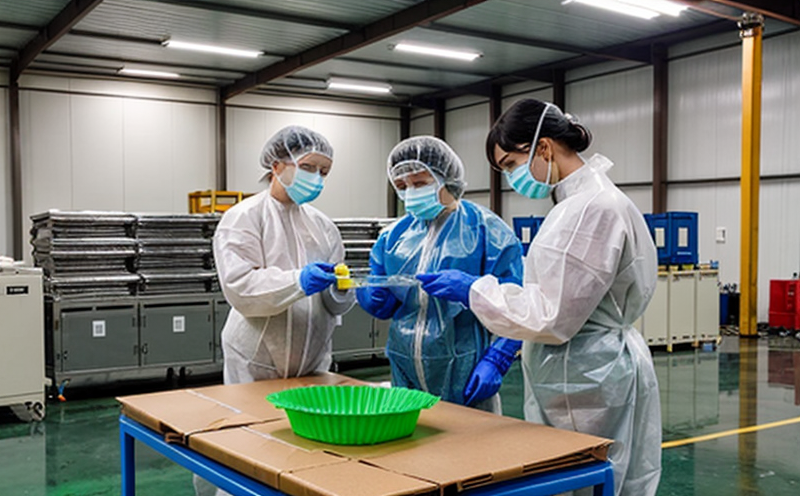ISO 62-4 Water Absorption Cycle Testing
The ISO 62-4 standard specifies a method to determine the water absorption properties of plastic packaging materials under cyclic immersion in water. This testing is crucial for ensuring that packaging materials remain structurally sound and impermeable to moisture, even after prolonged exposure to humid environments or aquatic conditions.
Water absorption can significantly impact the performance and durability of plastic packaging. It can lead to swelling, increased weight, reduced barrier properties, and compromised mechanical strength. These factors are especially important for food-grade packaging, medical devices, and other products that must maintain hygiene and integrity throughout their lifecycle. By conducting this test, manufacturers can ensure that their packaging meets regulatory requirements and performs optimally in real-world conditions.
The testing procedure involves cyclic immersion of the specimen into water at a controlled temperature, followed by drying. The absorption rate is calculated based on weight gain after each cycle. This helps identify materials with excessive moisture uptake, which could compromise product quality or lead to potential health hazards.
Specimen preparation for ISO 62-4 testing typically involves cutting the packaging material into standard size samples. These samples are then conditioned in a controlled environment before being immersed in water at specified temperature and duration intervals. Careful attention is paid to avoiding any contamination that could affect test results.
The test setup includes specialized equipment designed to control immersion times, temperature, and drying conditions accurately. The use of precise scales ensures accurate measurement of weight changes during each cycle. Rigorous calibration of all instruments used in the process guarantees reliable data collection throughout testing.
Acceptance criteria for this type of testing are based on maximum allowable water absorption percentages defined by the ISO standard itself. Compliance with these limits is essential to ensure that the packaging maintains its intended functionality and safety standards.
In summary, ISO 62-4 Water Absorption Cycle Testing provides critical insights into how plastic packaging behaves under dynamic moisture exposure scenarios. It enables manufacturers to optimize material selection, design robust packages capable of enduring harsh environmental conditions, and comply with relevant regulatory frameworks worldwide.
Why It Matters
Water absorption is a key factor affecting the performance of plastic packaging in various industries. For instance, in the food sector, excessive water uptake can lead to spoilage and contamination issues, directly impacting product safety and quality. In medical device manufacturing, moisture ingress might cause biocompatibility problems or even malfunctioning devices.
For companies operating internationally, meeting specific national standards like ISO 62-4 ensures consistent performance across different climates and regulatory environments. This not only enhances brand reputation but also facilitates smoother trade processes by avoiding non-compliance fines or recalls.
The results of this test play a vital role in product development too. By identifying weaknesses early on, developers can iterate designs more efficiently, reducing time-to-market delays and associated costs.
Furthermore, the data obtained from ISO 62-4 testing supports sustainability initiatives by helping manufacturers choose eco-friendly alternatives that still meet performance expectations without compromising quality or safety.
Industry Applications
| Industry | Application Examples |
|---|---|
| Food and Beverage | Ensuring shelf stability of canned goods, preventing cross-contamination in reusable containers. |
| Pharmaceuticals | Avoiding degradation issues with moisture-sensitive medications stored in flexible packaging. |
| Medical Devices | Guaranteeing sterility of implantable devices packaged in biocompatible materials. |
| Electronics | Preventing corrosion damage to components housed inside sealed enclosures during transportation or storage. |
Automotive: Insuring durability of fuel tanks and other reservoirs made from plastic materials.
Consumer Goods: Maintaining the integrity of cosmetics, cleaning products, and household items stored in flexible packaging.
Chemicals: Protecting reactive substances contained within specialized containers resistant to swelling due to water absorption.
Customer Impact and Satisfaction
Implementing ISO 62-4 Water Absorption Cycle Testing brings numerous benefits for businesses across multiple sectors:
Enhanced Product Quality: Ensures that packaging maintains its intended function, protecting products from contamination or damage.
Increased Customer Trust: Demonstrates commitment to high standards of hygiene and safety, fostering long-term customer relationships.
Improved Regulatory Compliance: Helps avoid costly penalties associated with non-compliance by adhering strictly to international regulations.
Competitive Advantage: Positions companies as leaders in their respective industries through superior product performance and reliability.
Sustainability Leadership: By selecting materials that perform well under rigorous testing conditions, businesses contribute positively towards environmental protection efforts.
Overall, successful implementation of this testing ensures not only compliance with industry standards but also contributes significantly to improving overall customer satisfaction levels.





